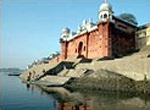|
|
|
The holy city of Varanasi, known as the city of temples and learning , is a place of great historical and cultural importance. This religious capital of India is situated on the banks of the holy river Ganges and is presided over by Lord Shiva. It is the heart of India and an epitome of the synthesis of cultures, religions and races. The river-front of the city is decorated by hundreds of well built ghats which is a unique feature. The holy Buddhist place, Sarnath is in its precincts.
Varanasi is the premiere most place of oriental learning. Simultaneously it is keeping pace with modern advanced knowledge. It has three universities : one Tibetan Institute and an Institute of Arabic Studies. The city is reputed for silk fabrics, perfumes, artistic brass and copper wares and a variety of handicrafts. It is an important center of literature, art and culture. It has produced great poets. writers, musicians and scholars. This vibrant city of joy knowledge and liberation has a magnetic attraction for people all over the world.
|
|
 The Ghats: The Ghats: |

Many a story has been told of the Ghats of Varanasi. Quite an amazing experience as you either walk along or brave the waters. This is the real Varanasi, with its godmen in saffron, the echoes of the shlokas, bathing pilgrims with prayers on their chilled and stuttering lips, the shoreline with flames lapping up towards the sky where the dead are sent to heaven - a thousand sights and smells assault and overwhelm you. The more famous of the Ghats are the Dasashwamedha, Manikarnika, Assi, Panch Ganga and Harishchandra Ghats.
|
|
 Vishwanath Temple: Vishwanath Temple: |
With the only constraint being that only Hindus are allowed inside the temple, the Vishwanath Temple was built in 1777, by Ahilya Bai Holkar of Indore. Aurangzeb's destruction of the temple and the rebuilding of it on the same site gives its history value and the temple has been the principal Shiva Temple in Varanasi for more than a thousand years. Known as the 'Golden Temple', because of the 800 kgs of gold, which adorns its shikharas, the roof was gold-plated by the blessing of Maharaja Ranjit Singh in 1835. In the inner sanctum, the shivling is enshrined atop a golden altar.
|
|
 Benares Hindu University Benares Hindu University |
The Benares Hindu University (BHU), as it is popularly known, was founded in 1917 by well-known nationalist Pt Malviya. The largest residential university in India, it houses an excellent Sanskrit School as also a museum within its campus, the Bharat Kala Bhavan Museum. The Museum has an amazing collection of old manuscripts, ancient sculptures and paintings.
|
|
 Bharat Mata Temple Bharat Mata Temple |
Dedicated to India, this temple was inaugurated by Mahatma Gandhi. Inside, there is a marble relief map of India and other related memorabilia. The symmetry of design and scale of the map catches your attention.
|
|
 Sarnath Sarnath |
15 kms from Varanasi lies Sarnath, one of the major Buddhist centers. This is where Lord Buddha preached his first sermon after attaining enlightenment, later Ashoka, the great Buddhist emperor erected magnificent stupas and monasteries here. After Muslim invaders destroyed and desecrated the Sarnath's buildings, it was little more than a shell. It was only in 1836 that British archeologists excavated Sarnath and it regained some of it's lost glory.
|
|
Visiting Time:
Varanasi can be visited throughout the year, but one must avoid the extreme hot summers (April-June). The most suitable time is in winters.
|
|
How to Reach:
By Air: Varanasi is connected with regular flights from Delhi, Agra and Mumbai.
By Bus: The city also has a good road network with good network of National and State Highways.
By Train: Varanasi is well connected by Super fast & daily express trains to almost all parts of North, East , Southern and Western India.
|
|
|